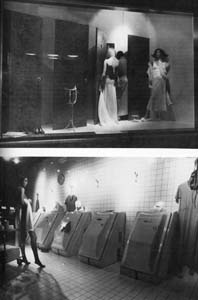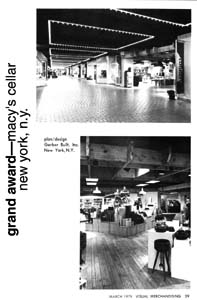During the transition years of 1968 to 1972, American youth dissociated itself from bygone eras, values and traditions. As the 60s slipped into the 70s, the counter-culture produced a new couture and the streets produced a new anti-fashion.
As the decade began, the war in Vietnam was raging on, Washington was mired in the corruption of Watergate and Americans waited in gas lines. With society still reeling from assassinations, riots and civil unrest, young people looked at traditional retail as uninspiring, frivolous and unimportant. Love became a mantra heard in the words and music of the younger generation. The sexual revolution led the way to the opening of closet doors and the forging of new identities. Anti-fashion demanded open attitudes, and set parameters for a broader scope of imagination. Changes in fashion were no longer considered cyclical or progressive, but rather avant-garde, revolutionary and radical.
Looking poor became chic. The street lords of anti-fashion adorned themselves with ragged jeans, long hair, beads and a mosaic of vintage clothes. Ethnic pride paved the way for Afros and dashikis, while new avenues of diplomacy introduced the West to the style and garb of Chairman Mao.
Inspired by ethnic tradition, designers soon included layers and mixed separates in their collections. Yves Saint Laurent stepped to the forefront of fashion in the early 70s by translating the ethnic and street look into high fashion.
The nuances of the street dominated fashion while “street theater” defined fashion windows. In 1976, Rosemary Kent coined the term in her New York Times piece on the new trend in fashion windows. With New York “street artists” setting the pace, this window genre soon spread across the country. At Chicago's Carson Pirie Scott, a window sequence escorted the viewer through a blissful night “Out on the Town.” The eight-window progression began with a grouping of beautifully bedecked women anticipating the night out, to the theater, to the bar, dinner, dancing, under the moonlight and then home alone with a cold compress. Audiences were alternately enthralled and outraged at this new vehicle for social commentary.
Advertisement
Mannequins became actors in real-life dramas. High-fashion outfits were center stage for murder, drug overdose and sexual intrigue. At Bloomingdale's, Candy Pratts raised eyebrows with sensational window presentations that led viewers on a trail of discovery. Displays featured women scrawling lipstick messages to each other across a mirror, suggesting a possible rendezvous; then a satisfied femme fatal lay musing between the white sale sheets. Ignoring architectural constraints, Pratts told complete stories that flowed from one window into the next.
When Pratts bolted onto the display scene in 1974, men had been dominating the profession. (The historians'ingenuous claim was that this was due to the long hours and heavy lifting required by the job.) However, attitudes were changing and barriers of social injustice were being torn down. It's significant to note that women were discouraged from wearing pants in formal settings, especially in the workplace. As a newfound feminism surfaced, mannequin attitudes assumed an air of self-assurance. “Dressing for success” became the catch phrase for women with visions of the corporate ladder instead of the social ladder. As Saint Laurent interpreted the passion of the streets, he introduced the reefer jacket, the safari suit and the all-important trouser.
Social awareness brought a new sense of realism to mannequin design. In 1972, Henry Callahan designed the “Contessa” mannequin for Saks Fifth Avenue's windows. A dramatic departure from the aloof, unblemished beauty of past mannequin creations, she represented a woman in her mid-thirties who, though of regal bearing, looked totally human. The decade's most telling mannequin innovation, however, was also a by-product of street theater. Increasingly, mannequins were designed to be sold as sets or groupings. Adel Rootstein was a trendsetter with collections of mannequins that interrelated as they appeared to talk, touch and listen to each other.
With new directions in store design, retailers began to think three-dimensionally, considering cubic measurement rather than simple square footage. Burdines'Town Center Store in Boca Raton, Fla. (designed by Walker Group), took advantage of the vertical planes created by the store's center core design. Vertical merchandising came into vogue as props, grids, photographic blow-ups and video images were integrated into a store's cubic space. The use of interior volume became an important tool, with perimeter walls communicating merchandise philosophy and fashion trend. While street theater fashion windows were limited to select stores, overall, the advent of vertical merchandising was the impetus for display's evolution into visual merchandising.


 Photo Gallery1 week ago
Photo Gallery1 week ago
 Headlines4 days ago
Headlines4 days ago
 Headlines1 week ago
Headlines1 week ago
 Headlines2 weeks ago
Headlines2 weeks ago
 Headlines1 week ago
Headlines1 week ago
 Designer Dozen1 week ago
Designer Dozen1 week ago
 Headlines1 week ago
Headlines1 week ago
 Headlines1 week ago
Headlines1 week ago
















